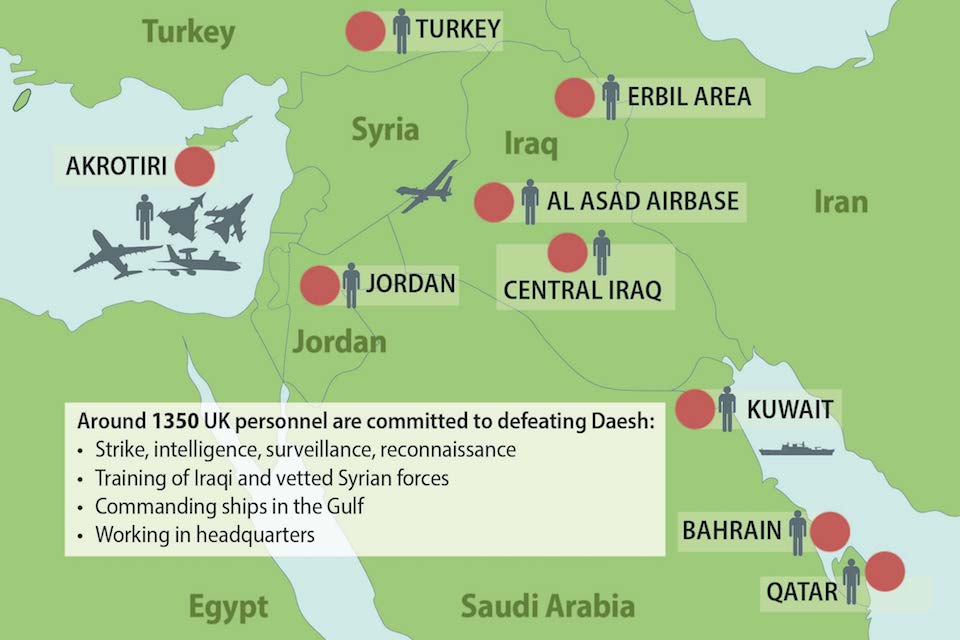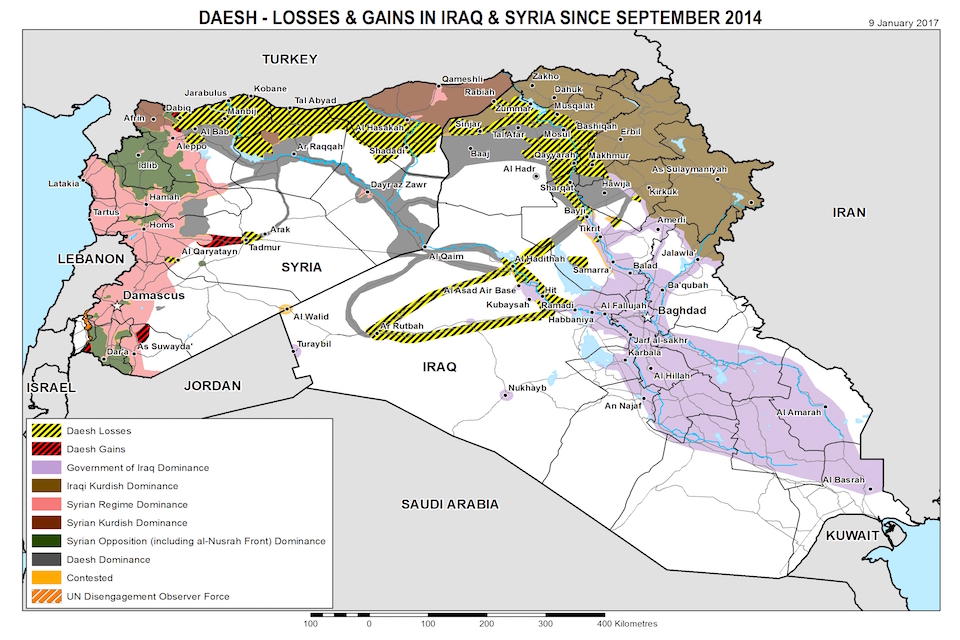The RAF are continuing to take the fight to Daesh in Syria.
Summary
Friday 1 June – Typhoons hit a command post in eastern Syria.
Sunday 3 June – a Reaper attacked another command post in eastern Syria, whilst Typhoons collapsed the entrance to a terrorist tunnel.
Monday 4 June – a Reaper destroyed an armed terrorist truck concealed under cover in eastern Syria.
Tuesday 5 June – a Reaper killed two terrorists on a motorcycle in eastern Syria.
Friday 8 June – a Reaper demolished a Daesh-held building in eastern Syria, and struck terrorists in the open.
Saturday 9 June – a Reaper knocked out both an armed terrorist truck and a mortar in eastern Syria.
Sunday 10 June – a Reaper eliminated a light machine-gun position in eastern Syria.
Monday 11 June – Typhoons attacked a Daesh-occupied cave, tunnel and bunker in northern Iraq.
Tuesday 12 June – a Reaper destroyed a terrorist mortar in eastern Syria.
Monday 18 June – Tornados destroyed an armoured truck concealed inside a building in eastern Syria.
Wednesday 20 June – Typhoons attacked a cave containing stockpiled weapons, in western Iraq.
Thursday 21 June – Typhoons bombed a hostile position which persisted in firing on coalition forces in southern Syria.
Saturday 23 June – a Reaper eliminated a Daesh mortar team spotted firing in eastern Syria.
Thursday 5 July – a Reaper struck a terrorist team planting improvised explosive devices in eastern Syria.
Saturday 7 July – Typhoons bombed a Daesh hide in northern Iraq.
Wednesday 18 July – a Reaper sealed off a cave containing stockpiled weapons in eastern Syria.
Detail
On Friday 1st June a Typhoon flight employed a single Paveway IV to demolish a smaller command post in the Euphrates Valley.
An RAF Reaper remotely piloted aircraft patrolled over eastern Syria on Sunday 3 June. It provided surveillance support to a coalition air attack on a terrorist vehicle, then followed up with two attacks with its own Hellfire missiles against a further Daesh command post. Meanwhile, Typhoons used a Paveway IV to collapse the entrance to a terrorist tunnel.
A Reaper provided further close air support to the Syrian Democratic Forces in the Euphrates valley on Monday 4 June. An armed terrorist truck was reported to be to the north of Abu Kamal, and the Reaper’s crew were able to identify the vehicle, parked under cover in an attempt to conceal it, after a thorough search. A Hellfire missile destroyed the vehicle, with a number of subsequent secondary explosions as ammunition on the vehicle caught fire. The following day, another Reaper operated over eastern Syria, some ten miles east of Al Shadadi. A pair of Daesh terrorists were tracked on a motorcycle, and both were killed by a direct hit from a Hellfire.
Reaper operations east of Al Shadadi continued on Friday 8 June; a terrorist was tracked to a building where he joined forces with other extremists, allowing the building to be struck with a Hellfire. The Reaper’s crew then conducted a further successful attack with a Hellfire as Daesh fighters sought new positions after artillery fire destroyed their previous location. On Friday 9 June, a Reaper used a Hellfire to destroyed a pick-up truck armed with a 23mm gun, which had been concealed under trees east of Al Shadadi. Another Hellfire missile then dealt with a mortar in the same area, with a number of secondary explosions following the attack on its position. A further Reaper attack east of Al Shadadi was conducted on Sunday 10 June, when our aircraft observed a light machine-gun position being set up in an orchard; a Hellfire quickly dealt with the threat.
Intelligence had allowed the identification of a small cluster of Daesh locations hidden in the hills south of Kirkuk, in northern Iraq. A flight of Typhoons were tasked with their destruction on Monday 11 June, and they delivered a simultaneous attack with Paveway IVs against a tunnel and a cave, then a further attack to destroy a bunker dug into the hillside. The following day, a Reaper was again in action east of Al Shadadi; its crew spotted a mortar hidden in trees and destroyed it with a direct hit from a Hellfire, whilst a coalition aircraft then conducted a successful strike on the building nearby where the terrorist team, who had been operating the mortar, were seen to be hiding.
Royal Air Force Tornado GR4s, supported by a Voyager air refuelling tanker, patrolled over eastern Syria on Monday 18 June. Daesh terrorists had been observed hiding an armoured truck inside a building to the west of the border with Iraq, and the Tornado flight was duly able to destroy the building, and the vehicle therein, with a single Paveway IV guided bomb.
Intelligence indicated that Daesh had a stockpile of weapons hidden inside a cave in a remote area of the western Iraqi desert; a pair of Paveway-armed Typhoon FGR4s therefore attacked on Wednesday 20 June, as part of the continuing effort to eradicate any attempts by the terrorists to resume operations within the country.
On Thursday 21 June, coalition forces operating against Daesh in the south of Syria were fired on by hostile positions, not believed to be held by Daesh. Although the coalition forces decided to withdraw to attempt to de-escalate the situation, one particular position continued to fire on them. As an act of collective self-defence, RAF Typhoons dropped a single Paveway IV on the position, which successfully removed the threat to our coalition partners.
A Reaper crew, flying an armed reconnaissance patrol over eastern Syria, close to the Iraqi border, on Saturday 23 June, were tasked to investigate reports of a Daesh mortar being fired. Using the aircraft’s advanced surveillance sensor suite, they were able to identify terrorists carrying mortar ammunition into a treeline where the weapon was concealed. One Hellfire missile killed the terrorists, a second destroyed the mortar position itself.
A Royal Air Force Reaper conducted an armed reconnaissance mission over the eastern borders of Syria on Thursday 5 July. A number of vehicles were seen and, after careful surveillance, identified as a refugee convoy. However, further down the road, a Daesh team was observed burying improvised explosive devices; given the threat these could pose to innocent traffic, an immediate attack was conducted using a Hellfire missile which put an end to the terrorists’ activities.
On Saturday 9 July, Typhoon FGR4s flew to northern Iraq, where a terrorist hide had been spotted, concealed in woodland on the bank of the Tigris to the north-west of Mosul. A single Paveway IV destroyed the site.
RAF aircraft continued to fly daily reconnaissance missions to identify potential Daesh activity, but did not need to engage a target until Wednesday 18 July. A cave in eastern Syria was confirmed as the location of a stockpile of terrorist weaponry, so a Reaper employed a GBU-12 guided bomb to deny Daesh access. The weapon scored a direct hit on the cave entrance and it was successfully collapsed.
UK contribution to the fight against Daesh

Campaign against Daesh

Previous update
Friday 4 May – Typhoons destroyed a truck-bomb factory in eastern Syria, whilst Tornados struck a terrorist position and vehicle in the countryside south of Kirkuk.
Saturday 5 May – Typhoons and Tornados demolished six buildings and a defensive position used by Daesh in eastern Syria.
A similar operation was carried out by Tornados on Friday 4 May; their target on this occasion was a terrorist position hidden in remote woodland some distance south of Kirkuk. Again, two Paveways were used, one striking the position, another taking care of the terrorists’ truck, parked nearby. Meanwhile, in Syria, intelligence analysis had identified a truck-bomb factory in a compound, east of the town of Abu Kamal. A pair of Typhoons successfully destroyed the factory with three Paveway IVs.
Further strikes were conducted in eastern Syria the following day, Saturday 5 May. Typhoons employed Paveway IVs to destroy three buildings which were being used by Daesh as an operating base, as well as a nearby defensive position. A Tornado flight similarly dealt with a large Daesh security post, established in three more buildings; each received a direct hit from a Paveway.
A flight of Royal Air Force Typhoon FGR4s were tasked on Wednesday 9 May to deal with two terrorists who had been spotted by a coalition surveillance aircraft as they moved on foot in the western desert of Iraq, some 25 miles south-east of Ar Rutbah. The Typhoons successfully located the terrorists and used a single Paveway IV guided bomb to strike them.
The following day, another Typhoon flight supported the Syrian Democratic Forces operating in the Euphrates valley. A large building, defended by Daesh extremists, had been identified to the north-north-west of Hajin. Having checked that there were no signs of any civilian presence in the vicinity, the Typhoons conducted an attack with two Paveway IVs which demolished the terrorist strongpoint.
Typhoons delivered a further attack against Daesh on Monday 14 May; a Paveway IV was employed to destroy successfully a mortar position and ammunition cache which had been spotted in eastern Syria. On Sunday 20 May, a pair of Tornado GR4s were tasked with the destruction of a tunnel complex which terrorists were attempting to reoccupy in the open countryside south-west of Mosul. Three tunnel entrances were identified, and each struck with a Paveway IV.
Daesh efforts to re-establish an operational presence in Iraq were struck a blow on Wednesday 23 May, when Royal Air Force Tornado GR4s guided a Paveway IV bomb onto a terrorist safe house which had been identified by intelligence at a remote wadi deep in the western desert of the country, some 65 miles south-east of Ar Rutbah. On Monday 28 May, a Tornado flight responded to a similar request for assistance when two Daesh extremists were spotted on a hillside in northern Iraq, some miles to the north of Makhmur; our aircraft delivered an attack with a Paveway IV.
Armed reconnaissance sorties also continued daily in support of the Syrian Democratic Forces in the east of the country. Two Paveway IVs from a Tornado flight scored direct hits on a Daesh strongpoint in a building to the north of Hajin, in the Euphrates valley, on Wednesday 30 May. The focus for RAF attacks for the remainder of the week were terrorist facilities in eastern Syria towards the border with Iraq. On Thursday 31 May, flights of Tornados and Typhoons joined forces to deliver an attack with twelve Paveway IVs against two large adjoining compounds, which were being used by Daesh as a headquarters, weapons store and muster point. All twelve weapons hit and destroyed their intended targets.
Details of previous airstrikes can be found here.
For more information see Daesh: UK government response page on GOV.UK







